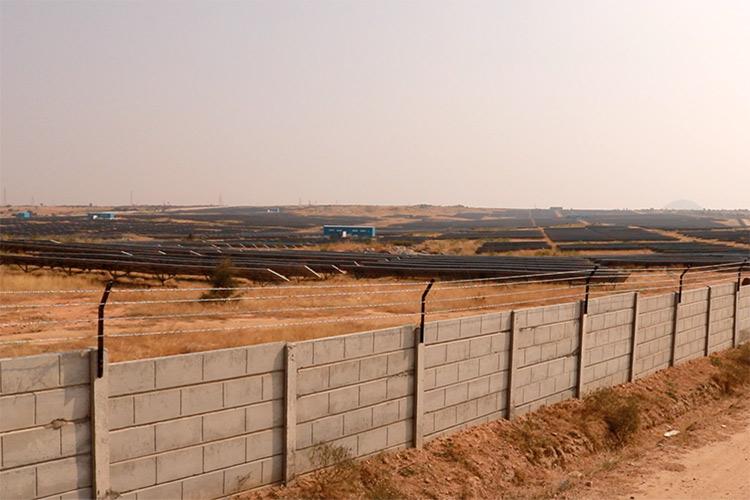It is easy to miss the town of Challakere on the National Highway 48 between Bengaluru and Chitradurga. Easier still to not notice the small road that deviates to the right to reach the village of Ularthi.
“Why bother finding our village,” asks Ranganna, 59, a farmer from the village. “It will not exist for much longer anyway,” he said sadly.
Twelve-feet tall walls rose adjoining his village in 2012. And since then, the walls have snaked further and further, cutting off Ularthi and 59 other villages from the sprawling open grazing lands.
Challekere taluk is home to Amrit Mahal Kavals or grazing lands, on which more than 2,50,000 goats, cows, bulls and sheep found food. About 3,00,000 people depended on these lands for livelihoods.
Since 2009, various levels of the government – district administration of Chitradurga, government of Karnataka and the Government of India – managed to discreetly divert close to 10,000 acres of lands in Challakere. “We didn’t know that these lands were not our commons until one of the shepherds was disallowed from entering the lands,” said Ranganna.
Authorities justified the secrecy because the space was used for defence purposes. In 2011, Srikumar Banerjee, the then chairman of India’s Atomic Energy Commission, spoke about the project rather tangentially. He reportedly said that the facility “could be used to produce nuclear fuel” to help nuclear energy in India.
The details of usage of these 10,000 acres became clear when the villagers filed a lawsuit at the High Court of Karnataka demanding a complete accounting of pasture land. They learnt from the state land registry that Defence Research & Development Organisation was given 4290 acres, Indian Institute of Science was given 1500 acres, Bhabha Atomic Research Centre had about 1810 acres diverted to it, Indian Space Research Organisation was given about 575 acres and some sundry lands were diverted to Karnataka Small Scale Industries Development Corporation.
A broader problem: these were crucial to preserve the ecological balance in Central Karnataka.
Chitradurga is a part of the Central Dry Zone and is worst affected by draught amongst all the ten agro-climatic zones of the state.
Not only would concretising such large swathes of land further push the region towards drought, but also have repercussions on other regions of the state. Forced labour migration from Challakere has already begun, and most younger people are reaching Bengaluru with little other than hopes of making ends meet.
“I drive cabs for Tech Mahindra and TCS,” said Mahesha, 24, who had come back to his village of Gowdagere for a few days. He was attending a town hall meeting in January where farmers were discussing strategies to save their lands from being converted into concrete structures furthering nuclear technology. “I have been driving taxis for a living for two years now. If one company doesn’t give me a job, another will,” he said. “But, I have to keep driving in order to ensure my parents in the village can survive,”
Civil Society in Challakere
At the town hall meeting of 60 villages in January, many civil society members from Bangalore and Chitradurga tried to infuse hope amidst the farmers. “All is not lost,” said Leo Saldanha, founder of a Bangalore based non-profit, Environment Support Group.
The National Green Tribunal, in 2014, has said none of these projects should go ahead unless they have secured environmental clearances, explained Saldanha. “Basis this, we should ensure there is a movement to stay the construction at Challakere,” he added.
However, despondent farmers emerged from the meeting, planning and strategising their migration to Bangalore. “Apparently only those in larger cities have rights, have a voice and can influence policy,” said Ranganna. “We will go to the capital to test our luck,” he added.
The past year has been particularly hard on the residents of Challakere taluk. Demonetisation hit the largely cash-based economies of livestock rearing hard, to top it, 2017 was the third successive year of drought.
District Collector of Chitradurga did not respond to repeated phone calls. Minister of Rural Affairs of Karnataka was also unavailable for comment on our questions on livelihoods for people who are forced to migrate to Bangalore.
“I blame both the Congress and the BJP governments for this mess,” said a farmer who requested anonymity. When the lands were diverted, the BJP was in power in the state and the Central government was headed by the Congress.
A lot of land is diverted for housing, recreation and other use of employees of DRDO, BARC and IISc, all of whom will have establishments in Challakere. “In most other cases, groundswell can turn policy around. But here, they have conveniently used the garb of national security to hide facts from us,” he added. The best example of this was when the residents of Doddulalarthi village boycott the 2014 general elections. “But to what avail?” the farmer asked rhetorically.
Sitting in the house of a senior farmer in Ularthi, some villagers are strategising for the upcoming assembly elections in Karnataka. “We cannot vote for either political party,” some say. “Neither has been our friend.”
“But a boycott also did not help us, did it?” asked another.
“How about all of us choose NOTA,” proposed a farmer. “We should convey to the establishment that we are still discontent, and what better time to do so than during elections,” he added. But they don’t reach a consensus. Most villages have different demands. While some of them want their lands back, others want better compensation and jobs.
Published in: The NewsMinute
Published on: May 3, 2018
Link: https://www.thenewsminute.com/article/how-people-chellakere-have-lost-their-livelihood-india-s-secret-nuclear-city-80612


